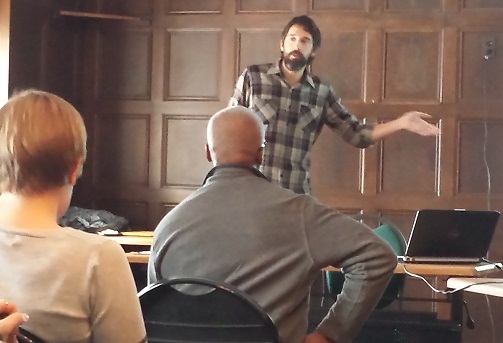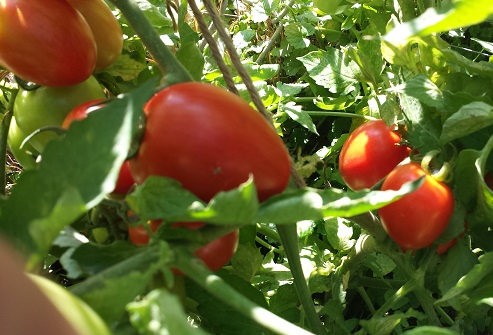July 31, 2016 – Veggies and Bonsai and Fruits (oh, my!)
The return of the snipologist
I received an email last night from my friend Dan Kosta from Vern Goers Greenhouse in Hinsdale, Illinois. The time stamp on the message said “10:45 p.m.” and Dan said he had just finished “working on my trees for the show.”
When he says “trees” he’s not talking about big trees or even small  trees. He’s talking about tabletop trees–in other words, bonsai. And the “show” to which he refers is the Annual Show presented by the Prairie State Bonsai Society on August 6 & 7 at the Morton Arboretum. For bonsai people like Dan, it’s a big deal. No wonder he’s out after dark, pruning and wiring his babies.
trees. He’s talking about tabletop trees–in other words, bonsai. And the “show” to which he refers is the Annual Show presented by the Prairie State Bonsai Society on August 6 & 7 at the Morton Arboretum. For bonsai people like Dan, it’s a big deal. No wonder he’s out after dark, pruning and wiring his babies.
If you’ve ever listened to The Mike Nowak Show (which you can do every Sunday morning at 9am on www.que4.org or later in the week at www.mikenowak.net/podcasts), you know that Dan is passionate about bonsai. And he has opinions to match his passion:
…many people don’t know that true bonsai is very different from the little plants surrounded by glued-on gravel sold at the home centers. If they come to our show they will see the genuine article. Its like the Elvis on black velvet vs. true art. We will have a tree display, vendors, demos, and workshops going on.
Bonsai in America is also finding its own identity which is not exactly the same as Japanese bonsai. This happened in Europe in the past decade or so and they are now the most innovative bonsai artists anywhere. Of course there is a battle between the purist establishment and the innovators.
If you’re interested a discipline that combines science, art, patience and, yes, passion, the Prairie State Bonsai Show is from 10:00 a.m. to 4:00 p.m. on Saturday, August 6 and Sunday, August 7 in the Sycamore Room at the Morton Arboretum, 4100 Illinois Route 53, Lisle, IL 60532.
AUA is having a soiree!
If you’re a fan of local food in Chicago, you should know about an organization called Advocates for Urban Agriculture (AUA). In their own words,
AUA is a coalition of individuals, organizations and businesses working to support and expand sustainable agriculture in the Chicago area, from home- and community-based growing to market gardens and small farms.
Allow me to give you a small sample of the kind of work they’re doing:
- AUA worked with the Mayor’s office, the Illinois Environmental Council (IEC), the Chicago Food Policy Action Council (CFPAC), and many other stakeholders for more than two years to amend Chicago’s outdated composting ordinance. Because of their work, community gardens and urban farms can accept and compost food scraps and other organic waste generated offsite.
- AUA’s Resources Working Group has been collaborating over the last few years with NeighborSpace, DePaul University’s Steans Center, and others to inventory and map gardens and farms across the Chicago area through the Chicago Urban Agriculture Mapping Project (CUAMP).
- On Thursday, August 11, AUA presents its 2nd Annual Grown in Chicago: Summer Soiree & Showcase, to raise money for their advocacy, outreach and education work. It will happen at Big Delicious Planet Canteen & Urban Farm, 412 N. Wolcott Avenue in Chicago.
 Billy Burdett explaining Chicago’s new composting ordinance at the 2016 Chicago Community Gardeners Association (CCGA) conference.
Billy Burdett explaining Chicago’s new composting ordinance at the 2016 Chicago Community Gardeners Association (CCGA) conference.
In fact, Billy Burdett, executive director of AUA, stops by today to talk about their various initiatives but particularly the upcoming event, which features a hyperlocal night market and showcase of Chicago urban farms and gardens, featuring diverse projects from around the city. There will also be live music, local beer and beverages, and a silent auction. It all happens between 6 and 9pm.
Managing 50,000 vegetables at the Chicago Botanic Garden
This is the time of year when you discover whether you knew what you were doing when you planted your veggies in your garden or your mind was elsewhere–perhaps on the dwarf planet Pluto. If things have gone well, you’re harvesting tomatoes and squash and beans and peppers and maybe even melons and more exotic edibles.
Now imagine if you’re not just in charge of 50,000 vegetable plants, but people pay to see them. Yoikes! That’s the job of Lisa Hilgenberg, Horticulturist at the Regenstein Fruit and Vegetable Garden at the Chicago Botanic Garden.
 Lisa Hilgenberg at a Chicago bloggers luncheon at CBG earlier this year. On the left is LaManda Joy from the Peterson Garden Project, and on the right, Craig LeHoullier, author of Epic Tomatoes.
Lisa Hilgenberg at a Chicago bloggers luncheon at CBG earlier this year. On the left is LaManda Joy from the Peterson Garden Project, and on the right, Craig LeHoullier, author of Epic Tomatoes.
She comes by it honestly–her father works Century Farms in Minnesota that have been in the family for 135 years! At CBG, Lisa employs USDA organic protocol and standards for managing the four-acre Fruit and Vegetable Garden following. She leads a crew of 4 and a team of 35 horticulture volunteers while curating and interpreting a collection of 600 edible plants, two orchards and an apiary, plus designing and installing large seasonal annual displays.
Today we’re going to talk about how to keep your own veggie garden going strong, including the trend of edible landscaping, which is emerging as a significant trend a in the farm/home to table movement. We’ll also discuss organic growing techniques as part of a broader systematic approach to sustainable practices.
I would be remiss if I didn’t mention the “tomato-palooza” at the Regenstein Fruit & Vegetable Garden on Saturday and Sunday,  August 27 and 28 from 11am to 4pm. The real name is Heirloom Tomato Weekend, and it features tips on growing and cooking with tomatoes, as well saving seeds, and advice about tomato problems. There are also tours of the tomatoes growing on the grounds and hands-on games and activities for the entire family.
August 27 and 28 from 11am to 4pm. The real name is Heirloom Tomato Weekend, and it features tips on growing and cooking with tomatoes, as well saving seeds, and advice about tomato problems. There are also tours of the tomatoes growing on the grounds and hands-on games and activities for the entire family.
One more thing. Lisa will give us a sneak preview of a brand new exhibit at CBG. the Regenstein Learning Campus. They describe it as a “seven-acre hub for plant-based community and civic engagement, intergenerational learning, hands-on coursework, and health and wellness activities.” Okay.
Anyway, they fling open the gates on Saturday, September 10 and Sunday, September 11 from 10am to 4pm. I’m even told that I will learn about something called “nature play.” Now I’m scared.
